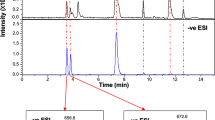Abstract
The high concentration (relative to seawater) of arsenic in many marine animals eaten as human food has stimulated interest in the cycling of arsenic in the marine environment1. Although arsenic is present as arsenobetaine [(CH3)3As+CH2COO−] in the western rock lobster2 (Panulirus cygnus), the dusky shark3 (Carcharhinus obscurus) and the school whiting4 (Sillago bassensis) it is not clear what intermediate stages are involved in the biosynthesis of this compound from arsenate, the major form of arsenic in seawater5. We now report the isolation of the two main arsenical constituents of the brown kelp, Ecklonia radiata, and their identification as a 2-hydroxy-3-sulphopropyl-5-deoxy-5-(dimethylarsenoso)furanoside and a 2,3-dihy-droxypropyl-5-deoxy-5-(dimethylarsenoso)furanoside. A β-ribo structure for the sugar system is strongly indicated in each case (A and B below). Ecklonia is the major organism that concentrates arsenic in the coastal ecosystem to which the western rock lobster and school whiting belong. It is clear that the compounds described here could readily be further metabolized to arsenobetaine and may well be the source of arsenobetaine in marine fauna associated with the region.
This is a preview of subscription content, access via your institution
Access options
Subscribe to this journal
Receive 51 print issues and online access
$199.00 per year
only $3.90 per issue
Buy this article
- Purchase on Springer Link
- Instant access to full article PDF
Prices may be subject to local taxes which are calculated during checkout
Similar content being viewed by others
References
Penrose, W. R. CRC crit. Rev. environ. Control. 4, 465–479 (1974).
Edmonds, J. S. et al. Tetrahedron Lett. 1543–1546 (1977).
Cannon, J. R., Edmonds, J. S., Francesconi, K. A. & Langsford, J. B. Management and Control of Heavy Metals in the Environment, Int. conf. Lond., 283–286 (CEP Consultants, Edinburgh, 1979).
Edmonds, J. S. & Francesconi, K. A. Mar. Pollut. Bull. (in the press).
Andreae, M. O. Deep Sea Res. 25, 391–402 (1978).
Merijanian, A. & Zingaro, R. A. Inorg. Chem . 5, 187–191 (1966).
Ritchie, R. G. S., Cyr, N., Korsch, B., Koch, H. J. & Perlin, A. S. Can. J. Chem . 53, 1424–1433 (1975).
Lindberg, B. Acta chem. scand. 9, 1097–1099 (1955).
Busby, W. F. Biochim. biophys. Acta 121, 160–161 (1966).
Cooney, R. V., Mumma, R. O. & Benson, A. A. Proc. natn. Acad. Sci. U.S.A. 75, 4262–264 (1978).
Maugh, T. H. II Science 203, 637 (1979).
Rochford, D. J. Aust. J. mar. Freshw. Res. 13, 226–251 (1962).
Massey, A. G., Randall, E. W. & Shaw, D. Spectrochim. Acta A23, 1235–1242 (1967).
Lemieux, R. U. & Stevens, J. D. Can J. Chem. 44, 249–262 (1966).
Inch, T. D. A. Rev. NMR Spectrosc. 2, 35–82 (1969).
Gorin, P. A. J. & Mazurek, M. Can. J. Chem . 53, 1212–1223 (1975).
Author information
Authors and Affiliations
Rights and permissions
About this article
Cite this article
Edmonds, J., Francesconi, K. Arseno-sugars from brown kelp (Ecklonia radiata) as intermediates in cycling of arsenic in a marine ecosystem. Nature 289, 602–604 (1981). https://doi.org/10.1038/289602a0
Received:
Accepted:
Issue Date:
DOI: https://doi.org/10.1038/289602a0
This article is cited by
-
Determination of chemical purity and isotopic composition of natural and carbon-13-labeled arsenobetaine bromide standards by quantitative1H-NMR
Analytical and Bioanalytical Chemistry (2016)
-
An approach for identification and determination of arsenic species in the extract of kelp
Analytical and Bioanalytical Chemistry (2015)
-
Selecting Australian marine macroalgae based on the fatty acid composition and anti-inflammatory activity
Journal of Applied Phycology (2015)
-
Biological response of free-living mouse Mus spretus from Doñana National Park under environmental stress based on assessment of metal-binding biomolecules by SEC-ICP-MS
Analytical and Bioanalytical Chemistry (2012)
-
Occurrence of arsenic species in the seagrass Posidonia oceanica and in the marine algae Lessonia nigrescens and Durvillaea antarctica
Journal of Applied Phycology (2010)
Comments
By submitting a comment you agree to abide by our Terms and Community Guidelines. If you find something abusive or that does not comply with our terms or guidelines please flag it as inappropriate.



